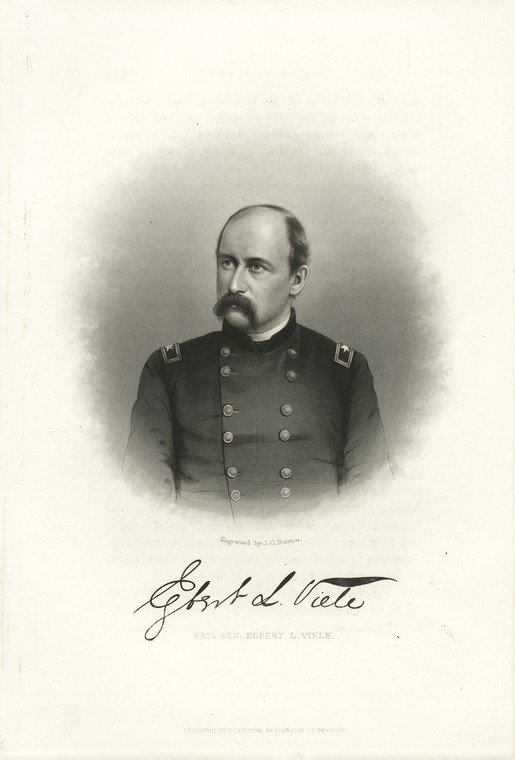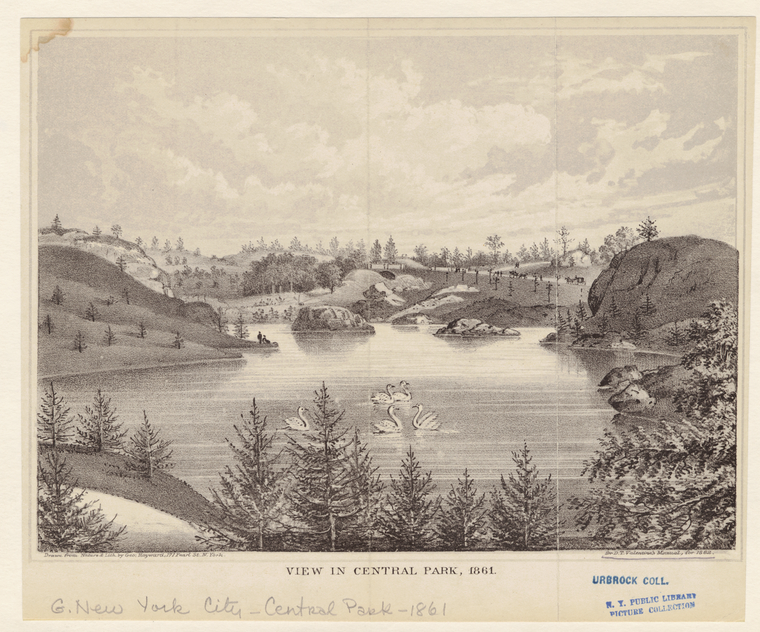NYC Neighborhoods
Survey and the City: An Imaginary Conversation With E.L. Viele

Viele is best know as the surveyor responsible for the popular topographic map Sanitary and Topographical Map of the City and Island of New York (now called the "Viele Map,") first published in 1865 and he is also responsible for the Topographical Atlas of the City of New York published in 1874. Both of his works show the original streams, marshes and coastline of New York City, superimposed over the present day street grid. On Feb 3, 1859 Viele gave testimony to the New York Senate on the disastrous effects of NYC’s topography and urban design on the health of its residents.
![] Plan for the improvement of the Central Park, adopted by the Commissioners, June 3rd, 1856., Digital ID 1697276, New York Public Library ] Plan for the improvement of the Central Park, adopted by the Commissioners, June 3rd, 1856., Digital ID 1697276, New York Public Library](https://images.nypl.org/?id=1697276&t=w)
E.L. Viele: Thanks for having me.
AW: Please tell our readers your opinion of the sanitary conditions of late 19th century New York City.
ELV: The sanitary condition of any city or district of country is so intimately connected with its proper drainage, and the latter is so dependent upon and governed by the topography of the locality that it would appear requisite that any enquiry into the causes or remedies for sanitary evils existing in the city of New York should be based upon a thorough knowledge of the topography of the island upon which it is built, and I have no hesitation in expressing the opinion that one of the chief causes of mortality is to be found in the defective drainage of certain districts of the city.
AW: How would you describe Manhattan’s pre-urban topography?
ELV: The topography of the island of New York varies from 5 to 150 feet above high-water mark; that between these two limits there is every variety of surface. In some sections the topography is of the most intricate description [with] abrupt ledges of rock, deep and narrow vallies [sic], sudden upheavals and contortions of the geological formations. Winding along this varied surface, in every direction, are the original drainage streams, one of them of such an extent that it was formerly used for mill purposes.

ELV: In laying out the city, the sectangular [sic] system of streets and avenues has been adopted, no reference whatever being made to the original topography of the island. The consequence is that the grading of the streets, especially in the upper part of the city, consists of deep rock excavations and high embankments, some of them as high as forty feet. These embankments cross, of course, the old vallies [sic] of drainage, through which flows the drainage-stream of a large area.
AW: Haven’t the city and private developers addressed these issues by constructing culverts when needed?
ELV: In most instances a few stones are thrown together and called a culvert for the purpose of letting these streams pass under the embankments. A few months suffice to destroy these culverts for the purpose of conductors, and the embankments soon become permanent dams, causing the collection of large bodies of water all over the island, which in mid-summer become stagnant pools, breeding pestilence and disease.
AW: “Pestilence and disease?” Please explain.
ELV: Whenever it becomes desirable to improve the lots adjacent to these embankments for sale or building purposes, earth is dumped in to absorb the water which is none the less present because it is not seen. The soil becoming saturated, forms a sort of sponge, through which the water ascends by capillary attraction, giving out a constant miasma, no less fatal to health than the stagnant water which it replaced.
AW: The city’s sewer system would address this, would it not?
ELV: Any system of sewerage, no matter how perfect, would not be a remedy for this evil, for the sewers are but ten or twelve feet below the grade of the streets, whilst, as has been stated, in some instances these streams are forty feet below grade of the streets, being thirty feet between the bottom of the sewer and the water drainage.
AW: Ok, point noted. Which part of Manhattan is most susceptible to these waterborne diseases?

AW: How can the city remedy this situation?
ELV: The remedy to be applied in the lower part of the city is to widen the narrow streets, and to raise the grade where the streets pass through the original depression of the surface.
AW: What’s wrong with narrow streets? Many people find them to be quaint and charming.
ELV: Narrow streets, under any circumstances, are a curse to a city. They are too generally the abodes of vice and crime. In them an ordinary sickness spreads into a pestilence, and a fire into a conflagration. They are always filthy in summer, and frequently blocked up with snow in winter. They are not fit for business purposes, for they stifle commerce, nor for residences, for they breed disease. Wide streets, on the contrary, are more healthy and cheerful for residences, and more useful and valuable for business purposes. There is less danger from fire, as the flames cannot spread across the street. They are cleaner in summer, and are never impassable in winter. [And] by constructing lateral drains along the slope of the depressions in the lower part of the city, and connecting them with the sewers, they will intercept the water in its descent and prevent its accumulation in the original basins.

ELV: As regards the upper part of the city, it is absolutely necessary that some system should be adopted for the free flow of water along the channels of the original drainage stream. This can be done by building more substantial culverts beneath the streets, and by the construction of permanent drains so, built as to admit of the percolation of water through the interstices of the covering. These drains should be excavated to a firm substratum, and every property owner should be compelled to construct, of a uniform character, that portion of each drain which may pass through his property.
AW: Thanks for communicating with our readers from the grave. If they have questions how can they contact you?
ELV: It has been my pleasure. I’ll be spending the rest of eternity with my second wife in our pyramid shaped mausoleum in West Point, New York. NYPL readers can reach me there.
Read E-Books with SimplyE
 With your library card, it's easier than ever to choose from more than 300,000 e-books on SimplyE, The New York Public Library's free e-reader app. Gain access to digital resources for all ages, including e-books, audiobooks, databases, and more.
With your library card, it's easier than ever to choose from more than 300,000 e-books on SimplyE, The New York Public Library's free e-reader app. Gain access to digital resources for all ages, including e-books, audiobooks, databases, and more.
If you don’t have an NYPL library card, New York State residents can apply for a digital card online or through SimplyE (available on the App Store or Google Play).
Need more help? Read our guide to using SimplyE.
Comments
Survey and the City
Submitted by Steven G Fullwood (not verified) on November 24, 2010 - 9:36am
great imagionary conversation
Submitted by Manuel (not verified) on July 29, 2015 - 8:10am
brief description about
Submitted by Manuel (not verified) on July 30, 2015 - 1:47am